Digital electronics is a field of electronics involving the study of digital signals and the engineering of devices that use or produce them. This is in contrast to analog electronics and analog signals.
Digital electronic circuits are usually made from large assemblies of logic gates, often packaged in integrated circuits. Complex devices may have simple electronic representations of Boolean logic functions.[1]
History[edit]
The binary number system was refined by Gottfried Wilhelm Leibniz (published in 1705) and he also established that by using the binary system, the principles of arithmetic and logic could be joined. Digital logic as we know it was the brain-child of George Boole in the mid 19th century. In an 1886 letter, Charles Sanders Peirce described how logical operations could be carried out by electrical switching circuits.[2] Eventually, vacuum tubes replaced relays for logic operations. Lee De Forest's modification of the Fleming valve in 1907 could be used as an AND gate. Ludwig Wittgenstein introduced a version of the 16-row truth table as proposition 5.101 of Tractatus Logico-Philosophicus (1921). Walther Bothe, inventor of the coincidence circuit, shared the 1954 Nobel Prize in physics, for creating the first modern electronic AND gate in 1924.
Mechanical analog computers started appearing in the first century and were later used in the medieval era for astronomical calculations. In World War II, mechanical analog computers were used for specialized military applications such as calculating torpedo aiming. During this time the first electronic digital computers were developed, with the term digital being proposed by George Stibitz in 1942. Originally they were the size of a large room, consuming as much power as several hundred modern PCs.[3]
The Z3 was an electromechanical computer designed by Konrad Zuse. Finished in 1941, it was the world's first working programmable, fully automatic digital computer.[4] Its operation was facilitated by the invention of the vacuum tube in 1904 by John Ambrose Fleming.
At the same time that digital calculation replaced analog, purely electronic circuit elements soon replaced their mechanical and electromechanical equivalents. John Bardeen and Walter Brattain invented the point-contact transistor at Bell Labs in 1947, followed by William Shockley inventing the bipolar junction transistor at Bell Labs in 1948.[5][6]
At the University of Manchester, a team under the leadership of Tom Kilburn designed and built a machine using the newly developed transistors instead of vacuum tubes.[7] Their "transistorised computer", and the first in the world, was operational by 1953, and a second version was completed there in April 1955. From 1955 and onwards, transistors replaced vacuum tubes in computer designs, giving rise to the "second generation" of computers. Compared to vacuum tubes, transistors were smaller, more reliable, had indefinite lifespans, and required less power than vacuum tubes - thereby giving off less heat, and allowing much denser concentrations of circuits, up to tens of thousands in a relatively compact space.
While working at Texas Instruments in July 1958, Jack Kilby recorded his initial ideas concerning the integrated circuit (IC), then successfully demonstrated the first working integrated circuit on 12 September 1958.[8] Kilby's chip was made of germanium. The following year, Robert Noyce at Fairchild Semiconductor invented the silicon integrated circuit. The basis for Noyce's silicon IC was the planar process, developed in early 1959 by Jean Hoerni, who was in turn building on Mohamed Atalla's silicon surface passivation method developed in 1957.[9] This new technique, the integrated circuit, allowed for quick, low-cost fabrication of complex circuits by having a set of electronic circuits on one small plate ("chip") of semiconductor material, normally silicon.
The metal–oxide–semiconductor field-effect transistor (MOSFET), also known as the MOS transistor, was invented by Mohamed Atalla and Dawon Kahng at Bell Labs in 1959.[10][11][12] The MOSFET's advantages include high scalability,[13] affordability,[14] low power consumption, and high transistor density.[15] Its rapid on–off electronic switching speed also makes it ideal for generating pulse trains,[16] the basis for electronic digital signals,[17][18] in contrast to BJTs which, more slowly, generate analog signals resembling sine waves.[16] Along with MOS large-scale integration (LSI), these factors make the MOSFET an important switching device for digital circuits.[19] The MOSFET revolutionized the electronics industry,[20][21] and is the most common semiconductor device.[11][22]
You received this message because you are subscribed to the Google Groups "1TopReadys1" group.
To unsubscribe from this group and stop receiving emails from it, send an email to 1topreadys1+unsubscribe@googlegroups.com.
To view this discussion on the web visit https://groups.google.com/d/msgid/1topreadys1/CAForgrSr9AFo%3DT9U%2BG_vKGamVWJ86vbkguvrq6U%2BOCGUNe-SSw%40mail.gmail.com.


No comments:
Post a Comment